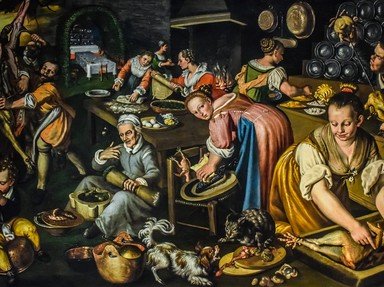Quiz Answer Key and Fun Facts
1. Many different types of objects were used as symbols in Renaissance art, but let's start with some fruits to whet our appetite.
Often taken to be the fruit consumed by Adam and Eve in the Garden of Eden, the apple is used to symbolise temptation and the fall of man. Which artist of the Northern Renaissance painted that biblical pair in 1507, three years after creating an engraving of the same scene?
2. A symbol of both eternal life and of prosperity, the pomegranate is often seen in Renaissance art. Found in the Uffizi in Florence alongside his best-known works, which Italian painter loved them so much he created a 'Madonna of the Pomegranate' in 1487?
3. Right, that's enough fruit for now, let's have a look at some animals.
The lamb can have a huge variety of meanings including peace and innocence, as well as being a direct symbol for Jesus Christ (the Lamb of God). In which Belgian city can you view the multi-panel altarpiece known as the 'Adoration of the Mystic Lamb'?
4. Thanks to their distinct multi-stage existence, butterflies are used to symbolised the cycle of life and resurrection. Which Roman god has laid down his lightning bolt to paint some butterflies in a painting by the Italian artist Dosso Dossi?
5. Snakes are rarely portrayed in a positive light in Renaissance art, often symbolising Satan, the fall of man, or just evil in general. Which student of Albrecht Durer made these negative connotations abundantly clear in his early 16th Century painting 'Eve, the Serpent and Death'?
6. We could talk about animals all day, but there are a couple of floral symbols lining up for our consideration.
Exemplified by Botticelli's 'Cestello Annunciation', which flower is used to symbolise the purity and virginity of Mary?
7. Particularly in the north of Europe, tulips were a symbol of prosperity and wealth. Originating in the late Renaissance, which of the following is a type of painting that contrasts such symbols with those of transience and death?
8. Given the prominence of religious subjects in Renaissance art, it can often be difficult to tell who's who. Thankfully, many religious figures have commonly-used symbols to help you pick them out of a crowd.
Perhaps the most famous saintly symbol are is the keys of St. Peter, exemplified in the Renaissance by Pietro Perugino's 'The Delivery of the Keys to Saint Peter' and El Greco's 'The Repentant Peter'. To which domain is he traditionally holding the keys?
9. An open book is often used to symbolise learning and knowledge, whilst a closed or torn book represents the rejection of knowledge. As in Antonello da Messina's painting of this name, which saint is often depicted 'in his study' with an open book?
10. Found in the Pinacoteca Nazionale in Bologna, which saint is shown casually carrying an entire organ in an altarpiece painted by Raphael?
Source: Author
pagea
This quiz was reviewed by FunTrivia editor
looney_tunes before going online.
Any errors found in FunTrivia content are routinely corrected through our feedback system.
